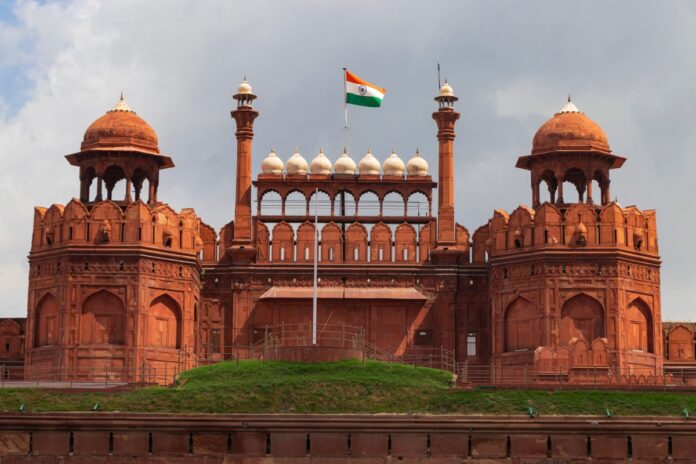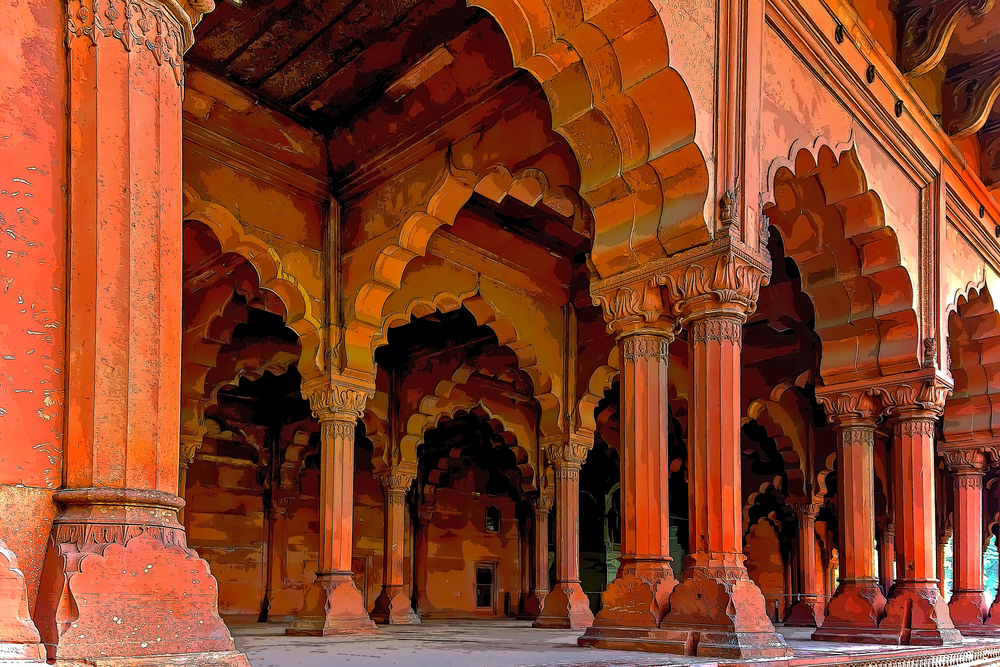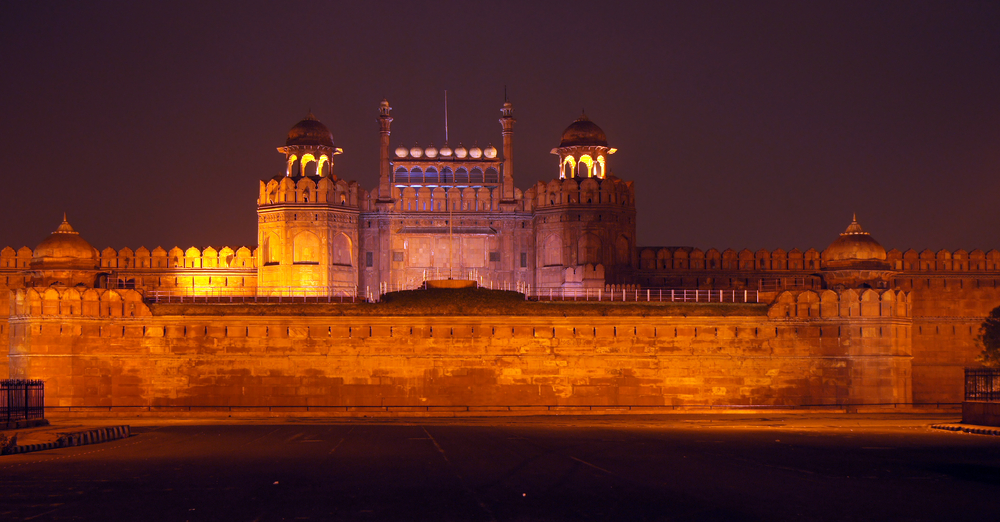Explore India’s past at the Red Fort in Delhi! This historic gem showcases stunning Mughal architecture and holds stories from long ago. Join us to learn about its fascinating history and why it’s so important for our country today.
Red Fort Delhi History
The Red Fort, a historic marvel located in Delhi, India, boasts a rich and intriguing history that spans several centuries. Here’s a detailed overview of its history:
Construction by Shah Jahan (1638-1648)
- The construction of the Red Fort was initiated by the Mughal Emperor Shah Jahan, renowned for the creation of the Taj Mahal.
- The construction began in 1638, and it took around a decade to complete the fort’s main structures.
Architectural Marvel
- The fort was designed by the accomplished architect Ustad Ahmad Lahori, who incorporated a fusion of Persian, Timurid, and Indian architectural styles.
- The use of red sandstone in its construction lent it the name “Red Fort.” The fort’s walls, bastions, and gates are all made of this distinctive material.
Recommended: Independence Day 2023 : Date, History, Significance, Celebration
Symbol of Power and Grandeur
- The Red Fort was intended to serve as the main residence of the Mughal emperors.
- It was designed not only as a royal residence but also as a symbol of the Mughal dynasty’s prestige and power.
Historical Significance
- The Red Fort has witnessed numerous historical events, including royal ceremonies, court proceedings, and important political announcements.
- It became the center of Mughal governance and cultural activities during its peak.
Decline and British Occupation
- After the decline of the Mughal Empire, the British East India Company took control of the fort in 1857 after the Indian Rebellion.
- The British repurposed parts of the fort for military use and made alterations to its structures.
Independence Day Speeches
- The Red Fort in Delhi gained further significance during India’s struggle for independence.
- On August 15, 1947, Jawaharlal Nehru, India’s first Prime Minister, delivered a historic speech announcing India’s independence from British rule.
UNESCO World Heritage Site
- In 2007, the Red Fort was designated as a UNESCO World Heritage Site for its architectural and historical importance.
Tourist Attraction
- Today, the Red Fort stands as one of India’s most iconic landmarks and a major tourist attraction.
- Visitors are drawn not only to its stunning architecture but also to the history it embodies.
National Celebrations
- The Red Fort continues to play a significant role in India’s national celebrations, particularly as the venue for the annual Independence Day flag hoisting ceremony.
The history of the Red Fort is a testament to India’s rich cultural heritage, reflecting the grandeur of the Mughal era and its enduring significance in the country’s narrative.
Red Fort Delhi Timings
Timings: 9.30 am to 4.30 pm (Closed on Mondays)
About Red Fort Delhi
- Historical Marvel: The Red Fort, commissioned by Emperor Shah Jahan in the 17th century, is a UNESCO World Heritage Site in Delhi, India.
- Distinctive Appearance: Named after its striking red sandstone walls, the fort showcases a fusion of Persian, Timurid, and Indian architectural styles.
- Royal Residence: It served as the primary residence of Mughal emperors for more than 200 years, symbolizing their power and opulence.
- Cultural Significance: The Red Fort hosted royal ceremonies, political events, and historical milestones, preserving India’s history within its walls.
- Independence Legacy: Jawaharlal Nehru’s historic speech on August 15, 1947, announcing India’s independence, was delivered from the Red Fort.
- Architectural Splendors: Notable features include the Lahori Gate, Chatta Chowk bazaar, and Diwan-i-Aam (Hall of Public Audience).
- Tourist Attraction: Its captivating architecture and historical importance continue to draw visitors worldwide.
- UNESCO Recognition: The fort’s architectural grandeur and historical value led to its designation as a UNESCO World Heritage Site.
- Cultural Gem: The Red Fort Delhi stands as a cultural gem, preserving India’s past and offering a glimpse into the country’s vibrant history.
Interesting Facts about Red Fort Delhi
Here are some intriguing facts about the Red Fort Delhi:
- Architectural Gem: The Red Fort’s intricate architecture is a blend of Persian, Timurid, and Indian styles, showcasing the Mughal era’s artistic brilliance.
- Color Symbolism: The fort’s red sandstone walls symbolize power and are a reflection of Mughal royalty.
- Diwan-i-Khas: The Diwan-i-Khas (Hall of Private Audience) famously housed the Peacock Throne, adorned with precious gems, including the Koh-i-Noor diamond.
- Largest Intricately Carved Door: The Lahore Gate, one of the fort’s entrances, boasts the largest example of intricately carved sandstone in India.
- Sound and Light Show: A captivating sound and light show at the fort narrates its history through colorful lights and captivating audio.
- Independence Day Celebrations: The Prime Minister of India hoists the national flag and addresses the nation from the Red Fort every year on Independence Day.
- Mumtaz Mahal: The Rang Mahal or “Palace of Colors” was originally built as a harem for Emperor Shah Jahan’s wives.
- Musical Pillars: The fort houses unique musical pillars that emit different musical notes when struck.
- Zubin Mehta’s Concert: In 2013, renowned conductor Zubin Mehta led a historic concert at the fort, promoting peace and cultural exchange.
- Water Management System: The fort had an advanced water supply and cooling system, with channels that provided cool air during the scorching summers.
- Intricate Marble Work: The Diwan-i-Am features stunning marble lattice screens, showcasing the Mughal artisans’ exceptional craftsmanship.
- Empire’s Decline: The British used the fort for various purposes after the decline of the Mughal Empire, even turning parts of it into barracks.
- Nahr-i-Bihisht: This “Stream of Paradise” was an elaborate water channel that flowed through the fort’s pavilions, adding to its beauty.
- Unique Pillared Structure: The fort’s Hammam or royal bath area is a fine example of Indo-Islamic architecture, complete with ornate pillars.
- Mughal Garden: The fort features a Mughal-style garden called Hayat Bakhsh Bagh, adorned with fountains and lush greenery.
The Red Fort’s history and features offer a glimpse into the grandeur of the Mughal period and its enduring legacy.
FAQs about Red Fort Delhi
Who built Red Fort in Delhi?
The Red Fort in Delhi was built by the Mughal Emperor Shah Jahan. He commissioned the construction of the fort in 1638, and it took several years to complete. The architect of Red Fort is Ustad Ahmad Lahori, who incorporated a blend of Persian, Timurid, and Indian architectural styles into its design. The Red Fort stands as a remarkable testament to the architectural and cultural brilliance of the Mughal era.
Mughal who built Red Fort in Delhi?
Delhi Red Fort built by the Mughal Emperor Shah Jahan. He ordered the construction of the fort in 1638 as part of his vision to create a magnificent seat of power and residence for himself and his successors. The Red Fort’s construction was completed in 1648, and it remains an iconic symbol of Mughal architecture and grandeur.
What is New Delhi to Red Fort’s distance?
The distance between New Delhi and the Red Fort in Delhi is approximately 5 to 6 kilometers. It usually takes around 20 to 30 minutes to travel from New Delhi to the Red Fort by car, depending on the traffic.







